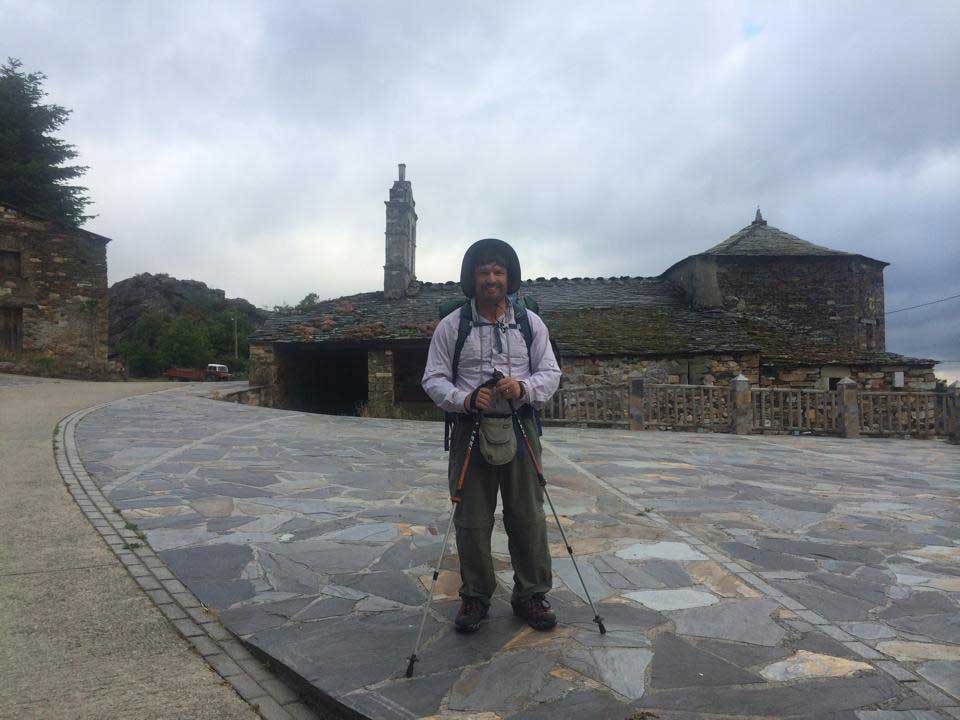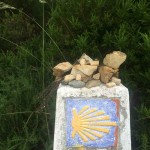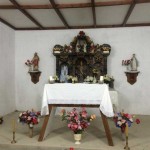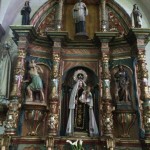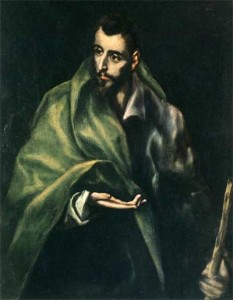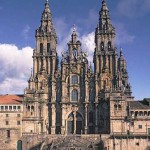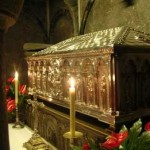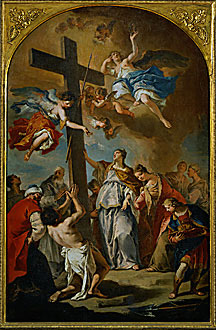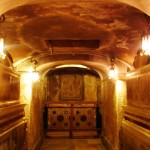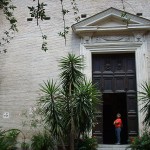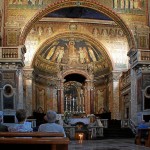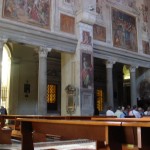BTP#Special -Â Pilgrimage
 [powerpress]
[powerpress]
We join Dr. Lilles on his pilgrimage following the Primitive Way or Original Way (known in Spanish as El Camino de Santiago Primitivo) which was the first pilgrimage route to Santiago de Compostela. Â He describes to us the true meaning of what it is to be called to “pilgrimage” (as opposed to just “trip taking”). Â We discuss the disposition of the heart and mind, as well as the significance of the “shrine”. Â A very compelling sharing on prayer and the journey of faith.
 Dr.Anthony Lilles is a Catholic husband and father of three teaching Spiritual Theology at St. John Vianney Theological Seminary. He teaches spiritual theology and spiritual direction to transitional deacons, and the spiritual classics to the men who enter the Spirituality Year, a year of prayer in preparation for seminary formation. He is the author of the “Beginning to Pray” Catholic blog spot. For other episodes in the series visit the Discerning Hearts page for Dr. Anthony Lilles
Dr.Anthony Lilles is a Catholic husband and father of three teaching Spiritual Theology at St. John Vianney Theological Seminary. He teaches spiritual theology and spiritual direction to transitional deacons, and the spiritual classics to the men who enter the Spirituality Year, a year of prayer in preparation for seminary formation. He is the author of the “Beginning to Pray” Catholic blog spot. For other episodes in the series visit the Discerning Hearts page for Dr. Anthony Lilles
Tags: catholic, catholic podcast, catholic prayer, cathollc spirituality, pilgrimage, the way
This entry was posted on Tuesday, July 1st, 2014 at 11:12 am
You can follow any responses to this entry through the RSS 2.0 feed.
The Feast of the Exaltation of the Holy Cross
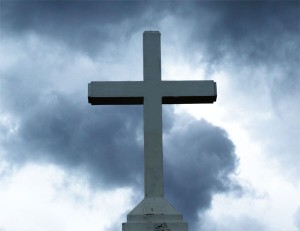 The instrument of our Master’s death is the instrument of His Triumph
The instrument of our Master’s death is the instrument of His Triumph
 It’s about the wood of the cross that hung the Savior of the world. It’s about the actual cross that was found by St. Helena on her pilgrimage in the 300’s AD and venerated for centuries. It’s about the cross around your neck, at one end of your rosary, on your wall. It’s about the sign we mark ourselves with every time we cross ourselves in the name of the Father, the Son and the Holy Spirit. It’s about all these things I suppose, and so much more. If one of the most horrific forms of execution can become transformed into the instrument of supreme redemption and life, then with God,  all things are really possible.
Behold the wood of the cross,
on which hung the Savior of the world.
Come, let us adore.
We worship you, Lord,
we venerate your cross,
we praise your resurrection.
Through the cross you brought joy to the world.
Glory to you, Jesus, Savior,
your cross gives us life.
Â
           Â
Tags: feast of the exaltation of the holy cross, pilgrimage, redemption, st helena, triumph
This entry was posted on Friday, September 14th, 2012 at 12:02 am
You can follow any responses to this entry through the RSS 2.0 feed.
BENEDICT XVI
GENERAL AUDIENCE
Wednesday, 21 June 2006
James, the Greater
We are continuing the series of portraits of the Apostles chosen directly by Jesus during his earthly life. We have spoken of St Peter and of his brother, Andrew. Today we meet the figure of James. The biblical lists of the Twelve mention two people with this name: James, son of Zebedee, and James, son of Alphaeus (cf. Mk 3: 17,18; Mt 10: 2-3), who are commonly distinguished with the nicknames “James the Greater” and “James the Lesser”.
These titles are certainly not intended to measure their holiness, but simply to state the different importance they receive in the writings of the New Testament and, in particular, in the setting of Jesus’ earthly life. Today we will focus our attention on the first of these two figures with the same name.
The name “James” is the translation of Iakobos, the Graecised form of the name of the famous Patriarch, Jacob. The Apostle of this name was the brother of John and in the above-mentioned lists, comes second, immediately after Peter, as occurs in Mark (3: 17); or in the third place, after Peter and Andrew as in the Gospels of Matthew (10: 2) and Luke (6: 14), while in the Acts he comes after Peter and John (1: 13). This James belongs, together with Peter and John, to the group of the three privileged disciples whom Jesus admitted to important moments in his life.
Since it is very hot today, I want to be brief and to mention here only two of these occasions. James was able to take part, together with Peter and John, in Jesus’ Agony in the Garden of Gethsemane and in the event of Jesus’ Transfiguration. Thus, it is a question of situations very different from each other: in one case, James, together with the other two Apostles, experiences the Lord’s glory and sees him talking to Moses and Elijah, he sees the divine splendour shining out in Jesus.
On the other occasion, he finds himself face to face with suffering and humiliation, he sees with his own eyes how the Son of God humbles himself, making himself obedient unto death. The latter experience was certainly an opportunity for him to grow in faith, to adjust the unilateral, triumphalist interpretation of the former experience: he had to discern that the Messiah, whom the Jewish people were awaiting as a victor, was in fact not only surrounded by honour and glory, but also by suffering and weakness. Christ’s glory was fulfilled precisely on the Cross, in his sharing in our sufferings.
This growth in faith was brought to completion by the Holy Spirit at Pentecost, so that James, when the moment of supreme witness came, would not draw back. Early in the first century, in the 40s, King Herod Agrippa, the grandson of Herod the Great, as Luke tells us, “laid violent hands upon some who belonged to the Church. He had James, the brother of John, killed by the sword” (Acts 12: 1-2).
The brevity of the news, devoid of any narrative detail, reveals on the one hand how normal it was for Christians to witness to the Lord with their own lives, and on the other, that James had a position of relevance in the Church of Jerusalem, partly because of the role he played during Jesus’ earthly existence.
A later tradition, dating back at least to Isidore of Seville, speaks of a visit he made
to Spain to evangelize that important region of the Roman Empire. According to another tradition, it was his body instead that had been taken to Spain, to the city of Santiago de Compostela. As we all know, that place became the object of great veneration and is still the destination of numerous pilgrimages, not only from Europe but from the whole world. This explains the iconographical representation of St James with the pilgrim’s staff and the scroll of the Gospel in hand, typical features of the travelling Apostle dedicated to the proclamation of the “Good News” and characteristics of the pilgrimage of Christian life.
Consequently, we can learn much from St James: promptness in accepting the Lord’s call even when he asks us to leave the “boat” of our human securities, enthusiasm in following him on the paths that he indicates to us over and above any deceptive presumption of our own, readiness to witness to him with courage, if necessary to the point of making the supreme sacrifice of life.
Thus James the Greater stands before us as an eloquent example of generous adherence to Christ. He, who initially had requested, through his mother, to be seated with his brother next to the Master in his Kingdom, was precisely the first to drink the chalice of the passion and to share martyrdom with the Apostles.
And, in the end, summarizing everything, we can say that the journey, not only exterior but above all interior, from the mount of the Transfiguration to the mount of the Agony, symbolizes the entire pilgrimage of Christian life, among the persecutions of the world and the consolations of God, as the Second Vatican Council says. In following Jesus, like St James, we know that even in difficulties we are on the right path.
Tags: apostle, martyr, pilgrimage, pope benedict xvi
This entry was posted on Wednesday, July 25th, 2012 at 8:49 am
You can follow any responses to this entry through the RSS 2.0 feed.
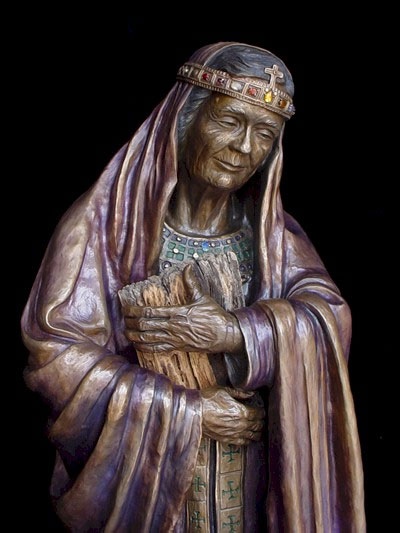 WHAT A LIFE…
WHAT A LIFE…
St. Helen was born in the middle of the third century, in what is now Great Britain; she was a good wife and mother. Life was pretty good. And then she was dumped by her ambitious husband for another woman in order to advance in rank (she was definitely done wrong!), and vanishes from history. Things look bad for Helen, UNTIL her son becomes emperor of Rome. Constantine, her son (yes, THE Constantine), brings her to Rome and sits her at his right hand, naming her “Augusta”, which means essentially, empress of all Rome (take that husband). What a good son he was! He made up to his mom what bad dad did to her!
OK, so far the story has gotten much better for our saint don’t you think, but wait it gets even better.
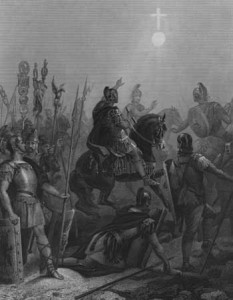 woman her husband threw her over for), and his vision of the big fiery cross over the sun which was his sign from Christ  to go on in battle and then on  to victory (it’s known as the Battle of the Milvian Bridge), Helen converts to Christianity. (Boy that was one long badly crafted sentence even for me…better take a breath)
woman her husband threw her over for), and his vision of the big fiery cross over the sun which was his sign from Christ  to go on in battle and then on  to victory (it’s known as the Battle of the Milvian Bridge), Helen converts to Christianity. (Boy that was one long badly crafted sentence even for me…better take a breath)Her faith becomes so fervent that we are told by one of the Fathers of the Church, Eusebius, that her son the emperor finances a complete pilgrimage for Helen to the Holy Land (what a good son). Now remember this IS the early 300’s and you can’t just hop on a plane or train. No sir,  if you’re now traveling royality, you have to have soldiers, priests, and whole lot of others to help you on your way. Helen, because she is the “Augusta”,  establishes countless churches all along that way.  She also  finds the places where Jesus lived and preached, and she establishes churches in those places too.  In her travels she finds the True Cross and brings that, along with the steps of Pontius Pilates’ Staircase (which you can climb today in a building just outside St. John Lateran’s in Rome, but do it on your knees and make sure, ladies, your shirts have sleeves,otherwise you will get yelled at by this little old guy in a suit, but I digress…)
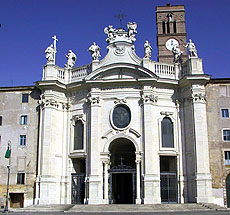
OK, now where was I… oh yes, St. Helen brings all those things (along with a huge boat load of Holy Land dirt) back to Rome. So thanks to the pilgrimage of St. Helen, when you and I go to Rome, we too can venerate the True Cross in the Church of the Holy Cross, which is just down the street from St. John Lateran (this is to say nothing of all the little pieces of the Cross that have been given away and are now all over the world). We can also visit the Holy Land in Rome, because of the “holy” dirt she brought back.
It’s all kind of neat when you think of it. Just when life seemed to hit rock bottom for Helen, it all turned around in an extraordinary way. An abandoned wife in England, becomes the empress of the known world of her time. So try to remember when you think you have hit rock bottom and can’t possibly get back up, ask St. Helen…all things are possible with God.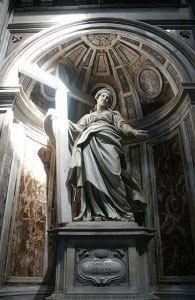
What ever happened to St. Helen after her wonderous pilgrimage? She died a devout and pious woman, the mother of the emperor, living into her 80″s, embracing the cross literally and figuratively.  Wow, what a life. She is considered by many  the patron saint for those divorced or divorcing!
  Evelyn Waugh, the author of BridesheadRevisited, wrote a wonderful novel centered on St. Helen. It’s really a fantastic  read.
Evelyn Waugh, the author of BridesheadRevisited, wrote a wonderful novel centered on St. Helen. It’s really a fantastic  read.
 Take a listen to Thomas Craughwell suggest that  St. Helen could be a patron saint for anyone who is divorced or divorcing (she’s been there).
Take a listen to Thomas Craughwell suggest that  St. Helen could be a patron saint for anyone who is divorced or divorcing (she’s been there).
[powerpress = “Morning-Show”]
Bruce and I talk with Thomas about Helen, along with a host of other marvelous members of the Cloud of Witnesses who become patron saints for us as we journey on our pilgrimage to heaven.
Tags: battle of the milvian bridge, catholic, catholic podcast, catholic prayer, cathollc spirituality, emperor of rome, eusebius, holy land, maxentius, pilgrimage, relics, st helen
This entry was posted on Thursday, August 18th, 2011 at 8:54 am
You can follow any responses to this entry through the RSS 2.0 feed.
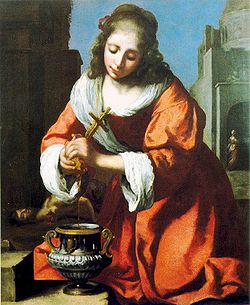 Today is the feast of one of my favorite “sister” saints, St. Praxedes. I found out about her when I went a pilgrimage a couple of years ago to Rome led by Scott and Kimberly Hahn and Mike Aquilina. It is believed that she, and her sister St. Pudentiana, were the daughters of St. Pudens (from 2 Timothy 4:21). She and her sister are remembered as saints of true mercy.Â
Today is the feast of one of my favorite “sister” saints, St. Praxedes. I found out about her when I went a pilgrimage a couple of years ago to Rome led by Scott and Kimberly Hahn and Mike Aquilina. It is believed that she, and her sister St. Pudentiana, were the daughters of St. Pudens (from 2 Timothy 4:21). She and her sister are remembered as saints of true mercy.Â
They lived in those early years of the Church, at a time of extreme Christian persecution. They hid Christians in their homes and visited the imprisioned. They even gathered the bodies of the dead after they were brutalized in the Coliesuum, and hid them in a well until they could be properly buried. St. Praxedes is  often depicted in art with a sponge soaked in blood; recalling how they cared for the precious blood of the martyrs after their awful executions. Their heoic virtue during these horrific years was so great that almost 2000 years later we still remember them.
often depicted in art with a sponge soaked in blood; recalling how they cared for the precious blood of the martyrs after their awful executions. Their heoic virtue during these horrific years was so great that almost 2000 years later we still remember them.
Their home was one of the first “house churches” in Rome. It is named after her sister, St. Pudentiana. Later another church was built and dedicated to St. Praxedes. Both are located near St. Mary Major in Rome. Click on the pictures to have a better look…
.
.
.
.
.
.
.
.
.
Tags: catholic, catholic podcast, catholic prayer, cathollc spirituality, churches in rome, martyrs, pilgrimage, saints
This entry was posted on Wednesday, July 21st, 2010 at 8:07 am
You can follow any responses to this entry through the RSS 2.0 feed.

